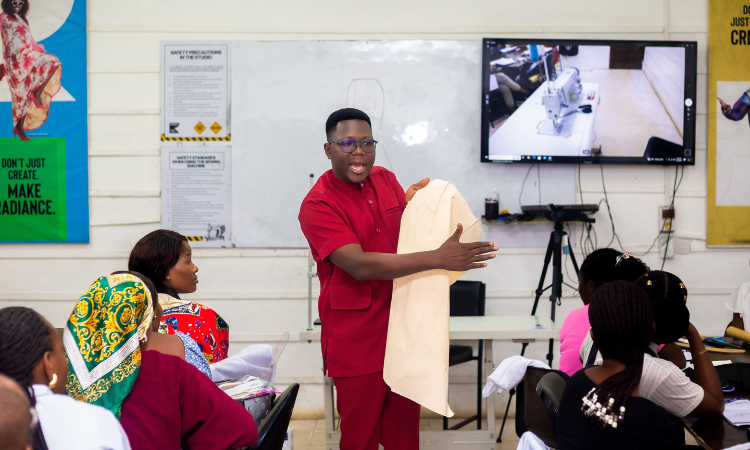
Sustainable Fashion: Educating the Next Generation of Designers
June 9, 2024In the rapidly evolving world of fashion, education is undergoing a significant transformation. The intersection of technology and traditional techniques is creating new opportunities and challenges for aspiring designers and educators alike. Richard Ohene Sika, a renowned Fashion Educator and Consultant, delves into how these changes are shaping the future of fashion education.
Integrating Digital Tools with Traditional Skills
Fashion education has traditionally focused on hands-on techniques such as sketching, pattern making, and sewing. These foundational skills are crucial, but the digital age demands a broader skill set. Tools like Adobe Illustrator for fashion design, 3D printing for creating prototypes, and virtual reality for immersive fashion shows are becoming indispensable.
Blending Digital and Traditional Skills
Richard emphasizes the importance of blending these digital tools with traditional skills. For instance, understanding fabric draping through physical manipulation complements the use of 3D modeling software. This hybrid approach ensures that students are well-rounded and adaptable to various aspects of the industry. By combining the tactile experience of handling fabrics with the precision and flexibility of digital design, students can push the boundaries of their creativity.
The Role of Digital Proficiency
Digital proficiency is not just about knowing how to use software; it’s about integrating these tools into the creative process. Adobe Illustrator, for instance, allows designers to experiment with colors, patterns, and textures in a way that traditional sketching cannot. Similarly, 3D printing enables the creation of prototypes that can be adjusted and perfected before moving to mass production, saving both time and resources.
Virtual Reality in Fashion Education
Virtual reality (VR) is another technological advancement that is making waves in fashion education. VR can create immersive experiences that allow students to explore fashion shows, attend workshops, and even participate in virtual internships. This technology provides a unique opportunity to experience the fashion world firsthand, even from a remote location.
Online Learning and Virtual Classrooms
The rise of online learning platforms has democratized access to fashion education. Students from around the globe can now learn from industry experts without geographical constraints. Richard points out that virtual classrooms enable a more diverse exchange of ideas and perspectives, enriching the learning experience.
Accessibility and Flexibility
Online platforms provide flexibility, allowing students to balance their studies with other commitments. This is particularly beneficial for those who may have full-time jobs, family responsibilities, or other constraints that prevent them from attending traditional classes. The ability to learn at one’s own pace and on one’s own schedule is a significant advantage.
Interactive and Engaging Learning
Interactive elements such as live demonstrations, virtual workshops, and digital portfolios enhance engagement and practical learning. Students can participate in live Q&A sessions, receive immediate feedback on their work, and collaborate with peers from different parts of the world. This interactivity bridges the gap between theoretical knowledge and practical application.
Diverse Perspectives and Global Reach
One of the most significant benefits of online learning is the diversity it brings. Students from different cultural and geographical backgrounds bring unique perspectives and ideas, fostering a richer learning environment. This global reach allows for a broader understanding of fashion trends, consumer behavior, and market demands across different regions.
The Role of Educators
Fashion educators play a pivotal role in integrating technology into the curriculum. Richard advocates for continuous professional development for educators to stay abreast of technological advancements. This proactive approach ensures that they can effectively guide students through both traditional and modern techniques.
Continuous Professional Development
Educators need to be lifelong learners themselves. By staying updated with the latest tools and technologies, they can better prepare their students for the industry. Workshops, webinars, and industry conferences are excellent opportunities for educators to expand their knowledge and bring fresh ideas into the classroom.
Adapting Teaching Methods
Integrating technology into the curriculum requires adapting teaching methods. Richard suggests using a mix of traditional lectures, hands-on workshops, and digital assignments. This blended approach caters to different learning styles and ensures a comprehensive understanding of both traditional and digital techniques.
Mentorship and Guidance
Beyond teaching, educators serve as mentors and guides. Richard emphasizes the importance of providing personalized feedback and support to help students navigate their educational journey. By fostering a supportive learning environment, educators can inspire confidence and creativity in their students.
Conclusion
Richard Ohene Sika’s insights into the future of fashion education highlight the importance of integrating technology with traditional skills. As the industry evolves, so too must the approaches to educating the next generation of designers. By embracing digital tools, leveraging online learning platforms, and ensuring continuous professional development for educators, fashion education can prepare students to excel in a dynamic and competitive field. This holistic approach not only enhances technical skills but also cultivates innovative thinking, preparing students to lead the fashion industry into the future.

